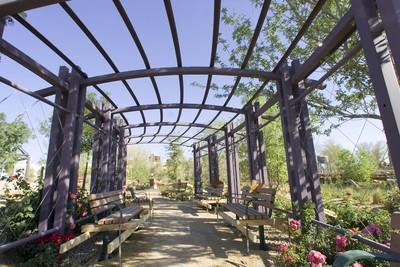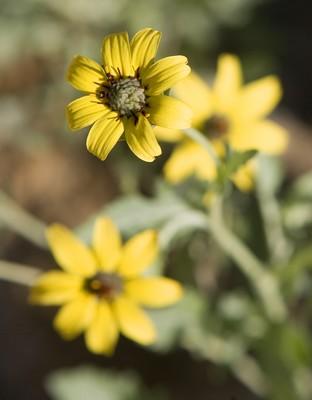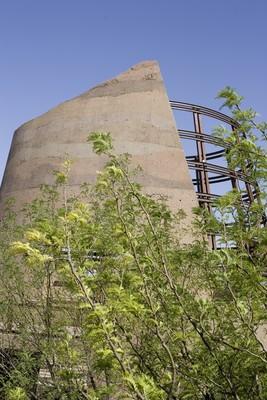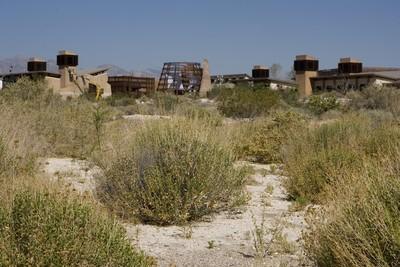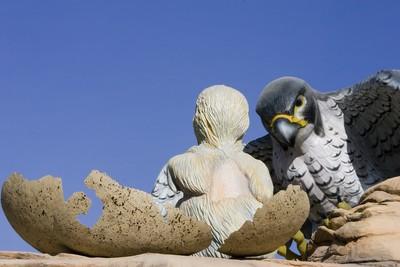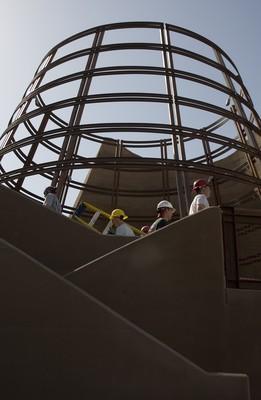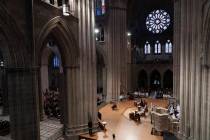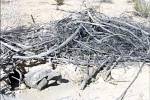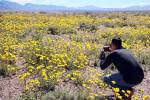Wet and wild Las Vegas
Thousands of years before Vegas Vic and the prime rib special, fresh water gushed from the ground at the center of the valley and trickled east toward the Colorado River, gathering plants, animals and people along the way.
It wasn't gambling that gave birth to Las Vegas. It was a natural supply of water.
Now the spring site that launched a thousand slot machines is being reborn as a gathering place of a different sort.
It's called the Springs Preserve, but regional water chief Pat Mulroy likes to think of it as the Central Park of Southern Nevada.
"Why not celebrate this place where all civilization in this valley began and has thrived ever since?" she said. "In a town that implodes everything, why not preserve something?"
Set to open to the public Friday, the $250 million cultural and educational complex features more than 176,000 square feet of museums, educational galleries and interactive exhibits, as well as an 1,800-seat outdoor amphitheater, a desert botanical garden with more than 30,000 plants, and a mile and a half of hiking trails.
All told, the Springs Preserve takes in 180 acres along the east side of Valley View Boulevard between U.S. Highway 95 and Alta Drive.
The land has been in the hands of the Las Vegas Valley Water District since 1954. It was added to the National Register of Historic Places as the Big Springs Archeological District in 1978.
Though she prefers to think of it as a team effort, Mulroy is widely credited for coming up with the idea for the preserve.
What Mulroy is willing to take credit for is the comparison to New York City's Central Park.
The general manager of both the water district and the Southern Nevada Water Authority said she first made that link during a staff meeting in the mid-1990s, and not because she wanted to see the property covered in grass and trees. What she envisioned was a place for the community to gather to learn about its past and contemplate its future.
Mulroy said those initial discussions about the preserve were triggered by growing interest in the L-shaped tract from commercial developers, state highway engineers and others hungry to see the property turned into something.
"When you have 180 acres of vacant land right downtown, everybody has their eyes on it," she said. "We realized we're sitting on a valuable cultural resource, and no one can see it."
The Springs Preserve is projected to draw as many as 750,000 visitors and bring in $14.5 million in revenue during its first year of operation. Out-of-town tourists are expected to account for roughly 70 percent of the volume.
"That is the optimistic gate number," said Jesse Davis, spokesman for the preserve. "Based on all the research we've done, the Springs Preserve warrants an optimistic approach."
And because the preserve is nonprofit, "all the proceeds are directed right back into the facility," he said.
Nearly 39 million people visited Las Vegas in 2006. Davis said research indicates that more than 1 percent of those visitors ventured off the Strip to "do the locals thing."
The Springs Preserve hopes to attract one out of every 100 tourists and, counting repeat visitors, one out of every 10 local residents.
So what if nobody shows up?
"I don't think that will happen," Mulroy said. "We were asked the same question when we opened a 2 1/2-acre botanical garden, and we were overwhelmed. That's why we had to expand."
Earlier this year, most of the plants from the water district's old Desert Demonstration Gardens were uprooted and moved across Alta Drive to become part of the preserve's 8 acres of botanical gardens.
A small army of contractors and staff members worked feverishly over Memorial Day weekend to prepare the preserve for opening day. Mulroy said she saw one project official and two members of the water district's administrative team sandblasting the parking lot Sunday. "These are the suit guys. Their jobs are usually at desks," she said.
And construction activity is far from finished at the site.
Over the next year, a 79,000-square-foot structure will be built to house the Nevada State Museum, located in nearby Lorenzi Park.
The museum was originally scheduled to open at the Springs Preserve in summer 2008, but the move has been delayed until spring of 2009.
"We had to push it back nine months. ... It's a big job, and we just wouldn't have been ready," said David Millman, curator and acting director of the state museum in Las Vegas.
Newcomers to the preserve, and Las Vegas, are encouraged to start their tours at the ORI-GEN Experience and visitor center, where they will get a taste of the valley's geology, geography, biology, history and prehistory stretching back 1.5 billion years.
That water-fueled story goes something like this:
The springs gave rise to a desert oasis of ponds, shade trees and waist-high grass, and that gave rise to all the wildlife and people that would follow.
First came the Anasazi, then the Pueblo, then the Paiute.
Behind them came members of Spanish trading caravans, who would rest at the springs during the long journey from New Mexico to the Pacific. You can credit them with coming up with a name that stuck: The Meadows, or Las Vegas in Spanish.
U.S. Army Capt. John C. Fremont was next to arrive in 1844, followed in subsequent waves by Mormon settlers, ranchers, miners, railroad men, mobsters, Celine Dion and so on.
After ORI-GEN, visitors can stroll over to the Desert Living Center, a five-building complex constructed to the highest standards for water and energy efficiency. There, they can learn how "green" design techniques can be put to work at home.
"Frankly, I think this project is one of the best things that's ever happened to Las Vegas," said Greg Seymour, who was a manager of the preserve for nine years before taking another job in August. "It will make people understand that history doesn't start with Bugsy Siegel."
To be successful, the exhibits need to hold people's attention long enough to teach them something, said Jay Nichols, general curator for the Springs Preserve.
"Trying to be historically accurate and make it fun is difficult," he said. "You try to do it in a way so that visitors don't realize they're being educated."
Nichols has no doubt the preserve will do the job.
"There's nothing else like it in this country. There are so many diverse things to do. It's better than Disneyland, and you'll learn something."
But not everyone is so enthusiastic.
Elizabeth Warren hates what's been done to the property, especially after she spent most of the last 35 years fighting to protect it from various highway projects and commercial developments.
The original plans for the preserve called for something decidedly more tranquil, "a place for people to try to understand why anyone came here in the first place," Warren said.
Then she and her fellow Friends of Big Springs were shut out of the process and the project mutated into a "$250 million, overbuilt entertainment complex," she said. "It's just like the rest of Las Vegas. It's all flash."
Warren said she expects any remaining archaeological treasures to be quickly trampled or carted off by visitors on the trails, and any remaining wildlife to be frightened away by the crowds and loud music from the outdoor amphitheater.
"That place was saved because people got involved -- everyday, ordinary people who worked like fury," Warren said. "At least once a decade, we had to mount a major campaign. Frankly, what they have done is a violation of everything that we fought to do there.
"I've been invited to their grand opening or whatever it is. I am not going. I am just furious."
Davis defended the efforts made so far to protect the site's cultural and biological features. That work will continue in earnest after the property opens to the public, he said.
The permanent staff of 125 includes experts whose job it is to identify and secure archaeological relics and protect sensitive wildlife, including the endangered Las Vegas bearpoppy, loggerhead shrike and desert pocket mouse.
In the coming months, the preserve hopes to expand its team of docents and other volunteers from 134 to about 400 to help keep visitors on the trails and out of trouble, he said.
Security is important for another reason. "This is an operational water storage and delivery site for the water district," Davis said.
The preserve's upper parking lot sits atop a 20 million gallon water reservoir, one of three such storage tanks on the property.
The valley's largest water utility supplied half of the funding for the project. The rest of the money came from a statewide bond issue approved by voters in 2002 (26 percent), revenue from the sale of federal land in the Las Vegas Valley (21 percent), and private donations (3 percent).
Mulroy said the water district's share of the money has been directed toward the Desert Living Center and the gardens, two features she considers "central to our mission" of fostering water conservation in the valley.
The district's contribution to the preserve will not require an increase in water rates, despite several sharp increases in the project's budget between conception and completion.
The estimated cost was $171 million when the preserve was first approved in April 2000. By the time of the official groundbreaking ceremony in June 2005, the cost had climbed to $200 million.
"It kind of grew," Mulroy said. "It took on a life of its own, like most projects do."
Preserve Director Francis Beland said his favorite exhibit is the one at the ORI-GEN Experience that replicates a desert flash flood, complete with 5,000 gallons of water dumped into an indoor canyon which then is recycled for the next downpour.
Beland doesn't apologize for elements of the preserve that some might dismiss as "infotainment."
"We are creating a cultural attraction here," he said. "It needs to be done in an entertaining way and a fun way and an educational way."
The goal is to make people feel connected to the community by teaching them about it.
"We need to create a sense of place and a sense of identity," Beland said. "Once we do that, we'll protect this environment and make this the best city in the Southwest."
Jane Feldman, conservation co-chairwoman for the Sierra Club in Southern Nevada, is looking forward to visiting the preserve.
Feldman said she appreciates the message the project is trying to send, but she worries that all the information on green building techniques and other conservation measures might distract from the need to talk about perhaps the biggest threat to sustainability: population growth.
"We really need to start the conversation about whether the driest place in North America can sustain a city of a million people," Feldman said.
The Springs Preserve may be the perfect venue for that conversation. Arguably one of the site's most powerful environmental messages involves the original springs themselves, which ran dry for good in 1962 after several years of heavy groundwater pumping on the property.
It was a mistake Mulroy said would not repeated today. "Our values have changed dramatically in the last 60 years."
So much groundwater was withdrawn from what is now the preserve that the ground collapsed in several places. In one spot, an old well casing still juts about five feet in the air, marking the extent of the subsidence.
That and other remnants from the water district's past will become interpreted stops on the network of trails around the Springs Preserve.
"This was not meant to be propaganda," Mulroy said of the project. "It was meant to be as honest as we could possibly make it, because positive change can't happen if you aren't honest."
GETTING THERE The Springs Preserve is reached via Meadows Lane, across from Meadows Mall off Valley View Boulevard. Hours at the preserve, which opens Friday, will be from 10 a.m. to 10 p.m. daily during the summer, 10 a.m. to 6 p.m. during the cooler months. Trails will close at dusk. Admission is $18.95 for most adults ($17.05 for seniors), or $14.95 ($13.45 for seniors) for Nevada residents. Admission is $13.45 for students and $10.95 for children 5 to 17 years old ($6.95 for Nevada residents), while children younger than 5 will be admitted free. In addition, annual passes are available, at $40 for an individual or $75 for a family of two adults and their dependents. Various areas of the preserve can be accessed free. Those include the 8 acres of botanical gardens, trail system, restaurant, playground and other parts of the commons area. Stroller and locker rentals will be available. There also is a 3,300-square-foot gift shop, which is a bit of a destination in itself. Part of the gift shop has a glass floor; a giant Gila Monster and oversized sidewinder can be seen beneath the floor. Video monitors will carry educational content. The gift shop will offer an array of items, with sustainability of the environment as an overriding theme. Merchandise will include books, stationery, clothing, bookmarks, posters, gardening items and food. The old Desert Demonstration Gardens on Alta Drive is closed to the public, because the botanical exhibits have been moved to the Springs Preserve. The visitors center at the garden remains open from 8 a.m. to 5 p.m. daily until Friday. HEIDI KNAPP RINELLA/REVIEW-JOURNAL



